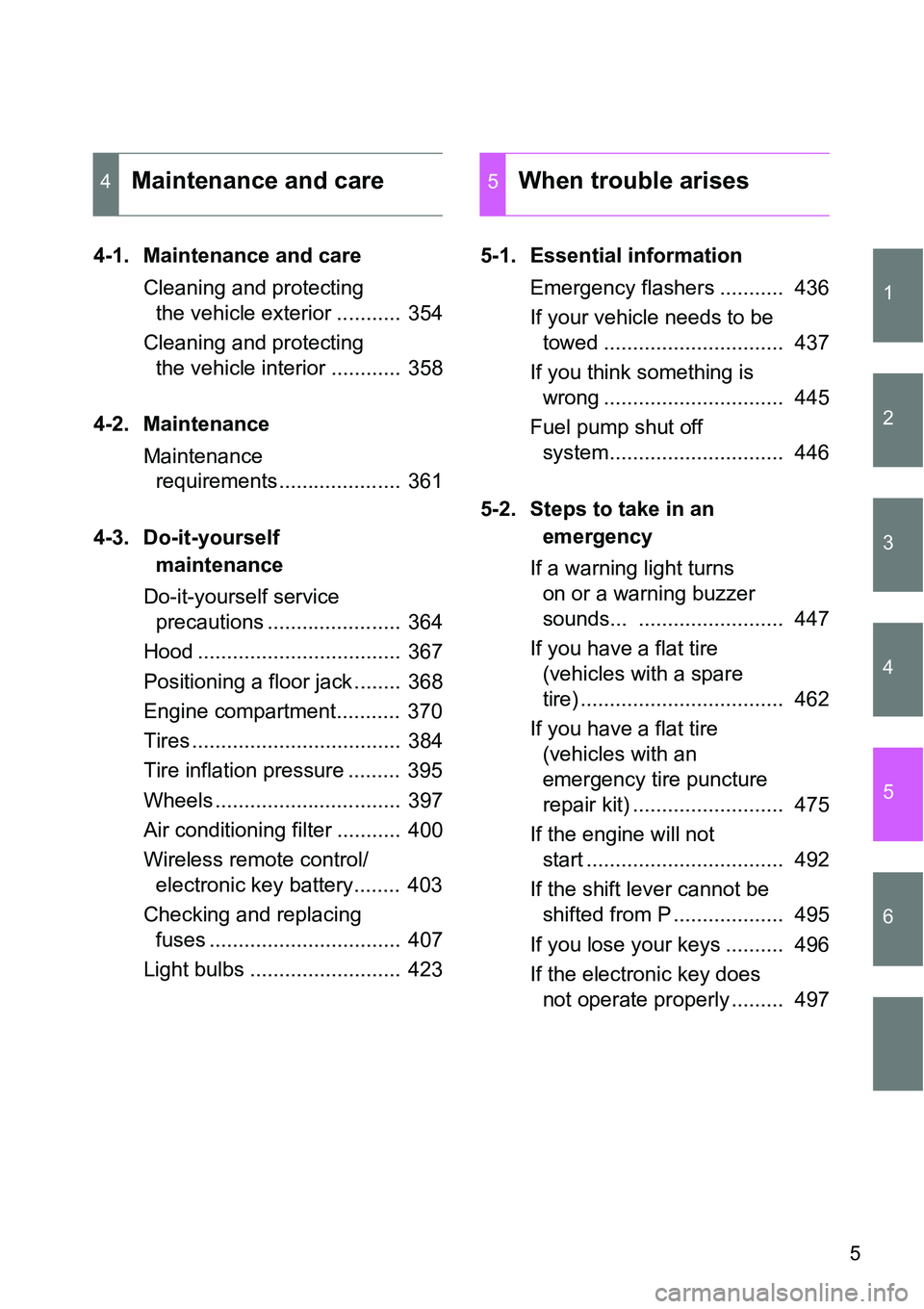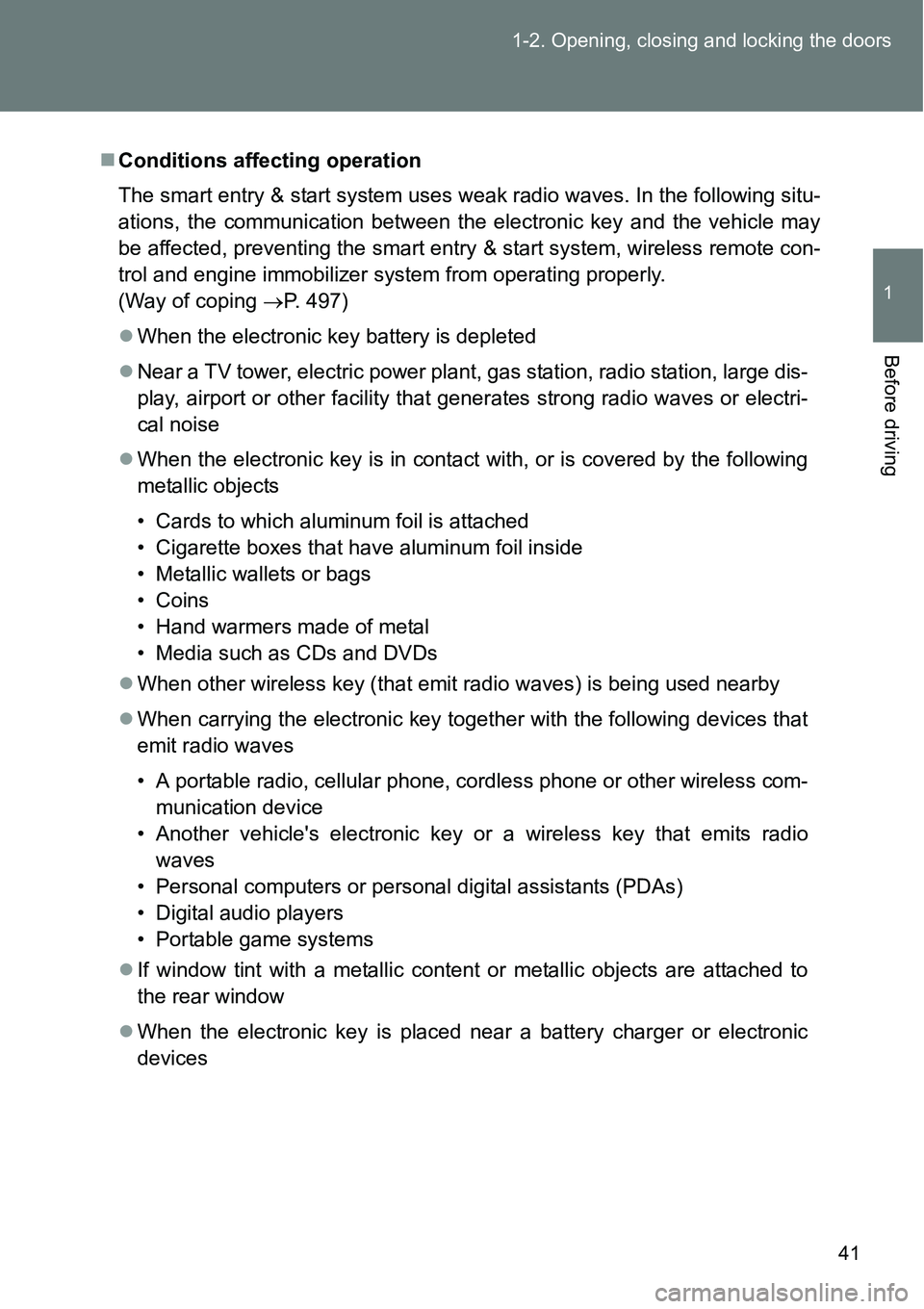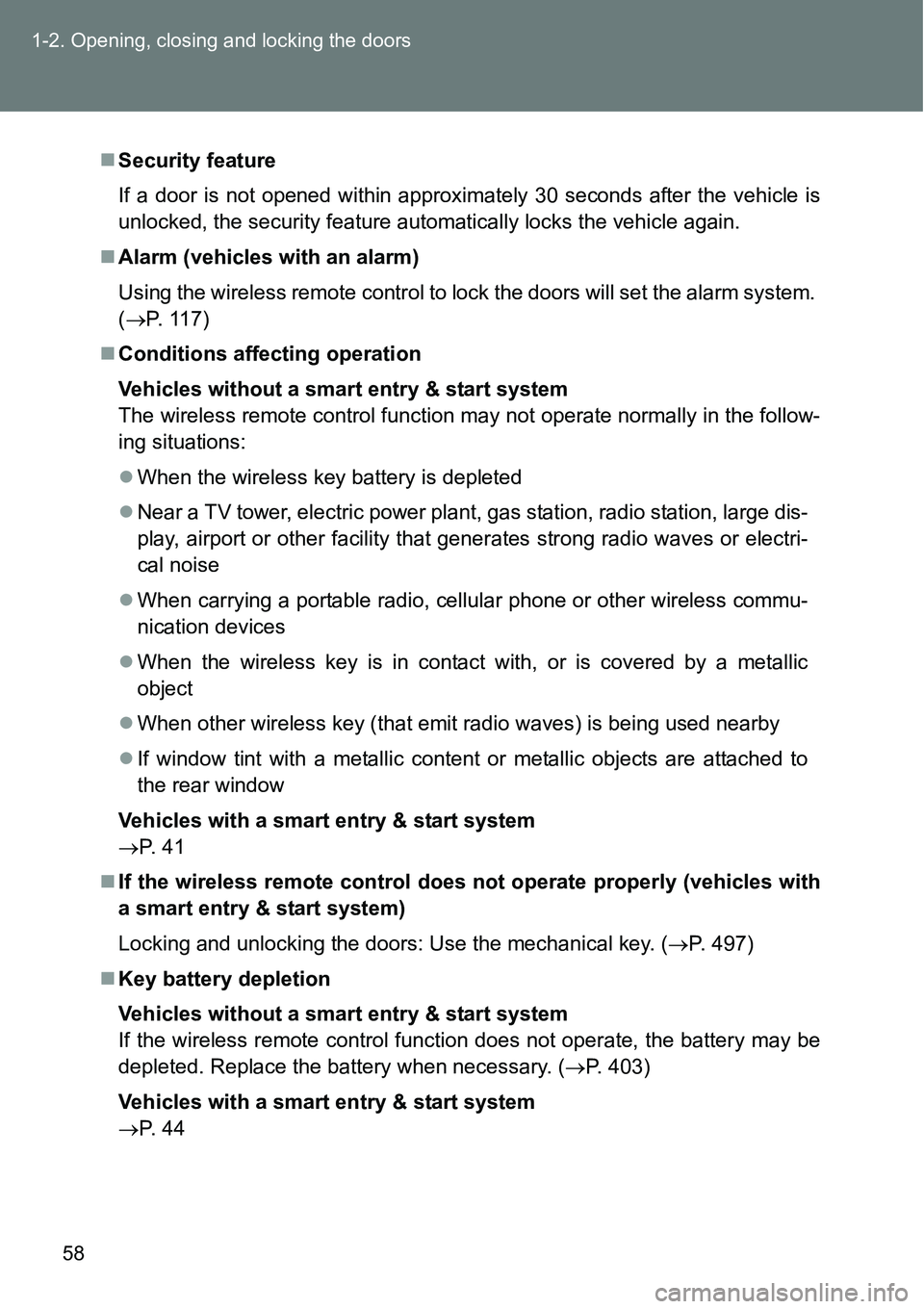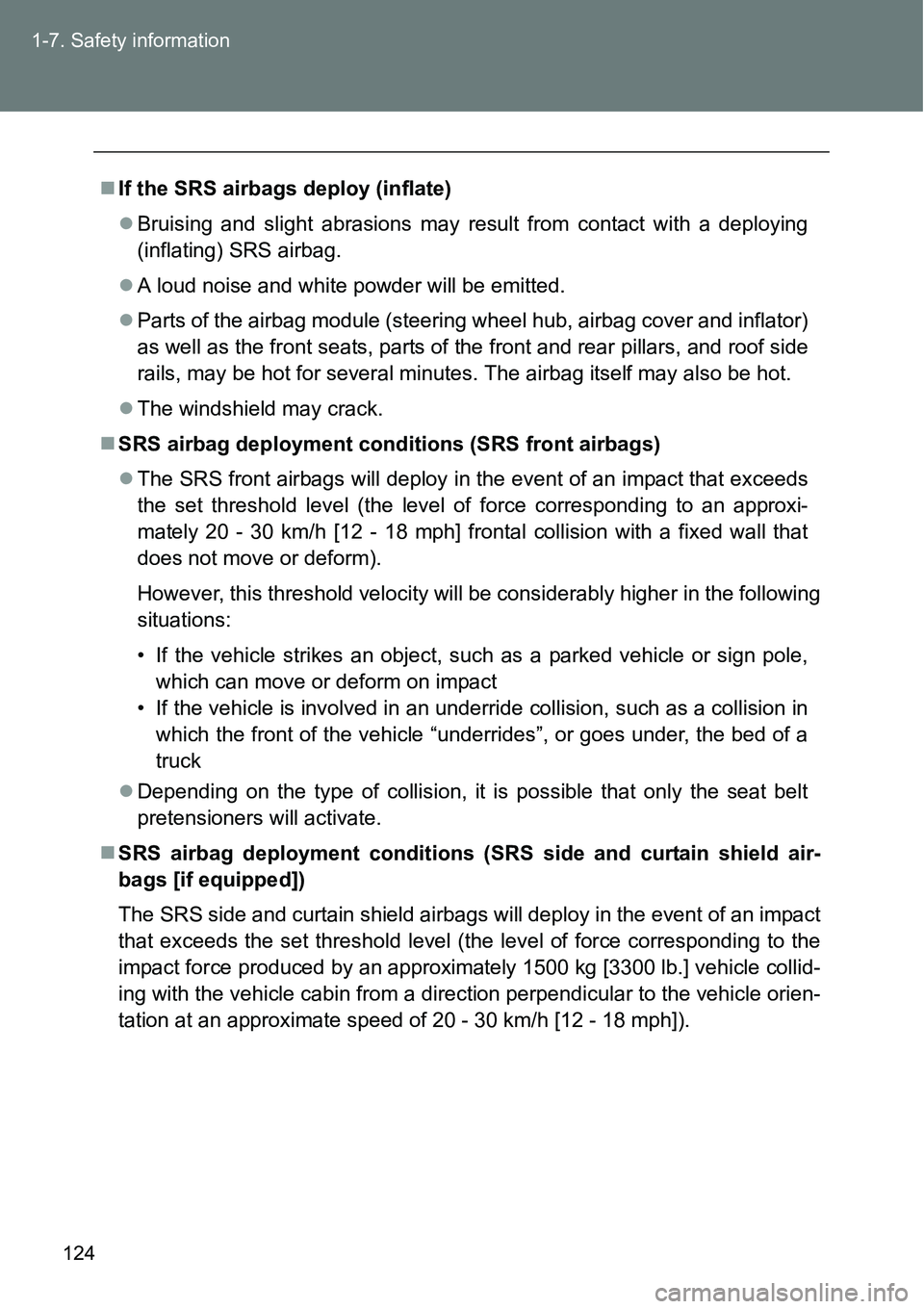Page 1 of 564
TABLE OF CONTENTS
1
1Before drivingAdjusting and operating features such as door locks,
mirrors, and steering column.
2When drivingDriving, stopping and safe-driving information.
3Interior featuresAir conditioning and audio systems, as well as other in-
terior features for a comfortable driving experience.
4Maintenance and
careCleaning and protecting your vehicle, performing do-it-
yourself maintenance, and maintenance information.
5When trouble
arisesWhat to do if the vehicle needs to be towed, gets a flat
tire, or is involved in an accident.
6Vehicle specifi-
cationsDetailed vehicle information.
IndexAlphabetical listing of information contained in this man-
ual.
Page 4 of 564

TABLE OF CONTENTSIndex
4
3-1. Using the air conditioning
system and defogger
Manual air conditioning
system .............................. 266
Automatic air conditioning
system .............................. 272
Power heater ...................... 279
Rear window and
outside rear view
mirror defoggers ............... 281
3-2. Using the audio system
Audio system types............. 283
Using the radio.................... 285
Using the CD player............ 289
Playing back MP3 and
WMA discs........................ 294
Operating an iPod ............... 301
Operating a USB
memory............................. 309
Optimal use of the audio
system .............................. 317
Using the AUX port ............. 319
Using the steering wheel
audio switches .................. 3203-3. Using the interior lights
Interior lights list ................. 323
• Personal lights ................. 324
• Personal/interior lights ..... 324
• Interior light ...................... 325
3-4. Using the storage
features
List of storage features....... 326
• Auxiliary box..................... 327
• Glove box ......................... 327
• Bottle holders ................... 329
• Tray .................................. 330
• Cup holders...................... 331
3-5. Other interior features
Sun visors .......................... 332
Vanity mirrors ..................... 333
Clock .................................. 334
Outside temperature
display .............................. 335
Power outlets ..................... 336
Seat heaters ....................... 338
Armrests ............................. 340
Panoramic roof shade ........ 341
Assist grips ......................... 344
Floor mat ............................ 345
Luggage compartment
features ............................ 347
3Interior features
Page 5 of 564

1
2
3
4
5
6
5
4-1. Maintenance and care
Cleaning and protecting
the vehicle exterior ........... 354
Cleaning and protecting
the vehicle interior ............ 358
4-2. Maintenance
Maintenance
requirements..................... 361
4-3. Do-it-yourself
maintenance
Do-it-yourself service
precautions ....................... 364
Hood ................................... 367
Positioning a floor jack ........ 368
Engine compartment........... 370
Tires .................................... 384
Tire inflation pressure ......... 395
Wheels ................................ 397
Air conditioning filter ........... 400
Wireless remote control/
electronic key battery........ 403
Checking and replacing
fuses ................................. 407
Light bulbs .......................... 4235-1. Essential information
Emergency flashers ........... 436
If your vehicle needs to be
towed ............................... 437
If you think something is
wrong ............................... 445
Fuel pump shut off
system.............................. 446
5-2. Steps to take in an
emergency
If a warning light turns
on or a warning buzzer
sounds... ......................... 447
If you have a flat tire
(vehicles with a spare
tire) ................................... 462
If you have a flat tire
(vehicles with an
emergency tire puncture
repair kit) .......................... 475
If the engine will not
start .................................. 492
If the shift lever cannot be
shifted from P ................... 495
If you lose your keys .......... 496
If the electronic key does
not operate properly ......... 497
4Maintenance and care5When trouble arises
Page 14 of 564
14
A
Vehicles with an automatic air conditioning system
Vehicles with a manual air conditioning system
Rear window and out-
side rear view mirror
defoggers switch
/
rear window defogger
switch
P. 281
Air conditioning
system
P. 272
Air conditioning
system
P. 266
Pictorial indexInstrument panel
(Left-hand drive vehicles)
Stop & Start cancel
switch
P. 231
“SPORT” switch P. 187
Stop & Start cancel
switch
P. 231
“SPORT” switch P. 187
Rear window and out-
side rear view mirror
defoggers switch
/
rear window defogger
switch
P. 281
Page 20 of 564
20
Rear window defogger
switch
P. 281
A
Vehicles with an automatic air conditioning system
Vehicles with a manual air conditioning systemAir conditioning
system
P. 272
Air conditioning
system
P. 266
“SPORT” switch P. 187
Rear window defogger
switch
P. 281
“SPORT” switch P. 187
Pictorial indexInstrument panel
(Right-hand drive vehicles)
Page 41 of 564

41 1-2. Opening, closing and locking the doors
1
Before driving
Conditions affecting operation
The smart entry & start system uses weak radio waves. In the following situ-
ations, the communication between the electronic key and the vehicle may
be affected, preventing the smart entry & start system, wireless remote con-
trol and engine immobilizer system from operating properly.
(Way of coping P. 497)
When the electronic key battery is depleted
Near a TV tower, electric power plant, gas station, radio station, large dis-
play, airport or other facility that generates strong radio waves or electri-
cal noise
When the electronic key is in contact with, or is covered by the following
metallic objects
• Cards to which aluminum foil is attached
• Cigarette boxes that have aluminum foil inside
• Metallic wallets or bags
• Coins
• Hand warmers made of metal
• Media such as CDs and DVDs
When other wireless key (that emit radio waves) is being used nearby
When carrying the electronic key together with the following devices that
emit radio waves
• A portable radio, cellular phone, cordless phone or other wireless com-
munication device
• Another vehicle's electronic key or a wireless key that emits radio
waves
• Personal computers or personal digital assistants (PDAs)
• Digital audio players
• Portable game systems
If window tint with a metallic content or metallic objects are attached to
the rear window
When the electronic key is placed near a battery charger or electronic
devices
Page 58 of 564

58 1-2. Opening, closing and locking the doors
Security feature
If a door is not opened within approximately 30 seconds after the vehicle is
unlocked, the security feature automatically locks the vehicle again.
Alarm (vehicles with an alarm)
Using the wireless remote control to lock the doors will set the alarm system.
(P. 1 1 7 )
Conditions affecting operation
Vehicles without a smart entry & start system
The wireless remote control function may not operate normally in the follow-
ing situations:
When the wireless key battery is depleted
Near a TV tower, electric power plant, gas station, radio station, large dis-
play, airport or other facility that generates strong radio waves or electri-
cal noise
When carrying a portable radio, cellular phone or other wireless commu-
nication devices
When the wireless key is in contact with, or is covered by a metallic
object
When other wireless key (that emit radio waves) is being used nearby
If window tint with a metallic content or metallic objects are attached to
the rear window
Vehicles with a smart entry & start system
P. 4 1
If the wireless remote control does not operate properly (vehicles with
a smart entry & start system)
Locking and unlocking the doors: Use the mechanical key. (P. 497)
Key battery depletion
Vehicles without a smart entry & start system
If the wireless remote control function does not operate, the battery may be
depleted. Replace the battery when necessary. (P. 403)
Vehicles with a smart entry & start system
P. 4 4
Page 124 of 564

124 1-7. Safety information
If the SRS airbags deploy (inflate)
Bruising and slight abrasions may result from contact with a deploying
(inflating) SRS airbag.
A loud noise and white powder will be emitted.
Parts of the airbag module (steering wheel hub, airbag cover and inflator)
as well as the front seats, parts of the front and rear pillars, and roof side
rails, may be hot for several minutes. The airbag itself may also be hot.
The windshield may crack.
SRS airbag deployment conditions (SRS front airbags)
The SRS front airbags will deploy in the event of an impact that exceeds
the set threshold level (the level of force corresponding to an approxi-
mately 20 - 30 km/h [12 - 18 mph] frontal collision with a fixed wall that
does not move or deform).
However, this threshold velocity will be considerably higher in the following
situations:
• If the vehicle strikes an object, such as a parked vehicle or sign pole,
which can move or deform on impact
• If the vehicle is involved in an underride collision, such as a collision in
which the front of the vehicle “underrides”, or goes under, the bed of a
truck
Depending on the type of collision, it is possible that only the seat belt
pretensioners will activate.
SRS airbag deployment conditions (SRS side and curtain shield air-
bags [if equipped])
The SRS side and curtain shield airbags will deploy in the event of an impact
that exceeds the set threshold level (the level of force corresponding to the
impact force produced by an approximately 1500 kg [3300 lb.] vehicle collid-
ing with the vehicle cabin from a direction perpendicular to the vehicle orien-
tation at an approximate speed of 20 - 30 km/h [12 - 18 mph]).